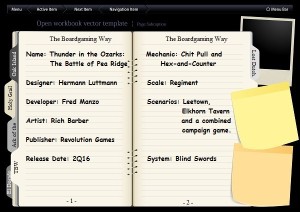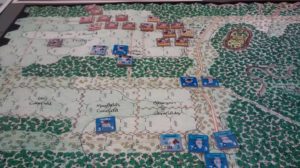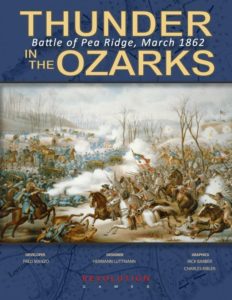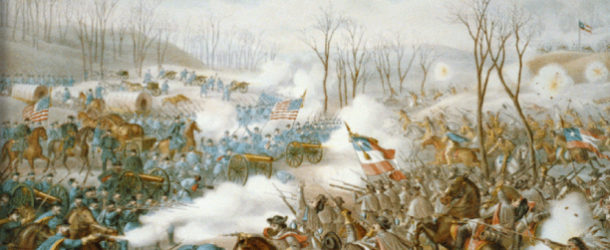A revelation for me, fantastic gameplay and narrative, but also sending me down all sorts of historical rabbit holes. Hermann Luttmann has extended the chit pull system beyond activating divisions and adds conditional events (interuptions of command, sudden heroism in a calvery charge, a moment of tactical coherance in the confusion, a surprise artillery barrage at canister range (holy shit!), the paralysis of a unit or its wandering into the wood); and then picking an activation chit for a division comes with the leader activation roll that basically means, “hold on buddy, just because you activated a commander doesn’t mean he decides to get some breakfast in his tent instead of tending to this little situation.” All of this serves to keep you madly fluctuating between planning & reacting, but it also produces moments of clarity and initiative that cultivates the instincts to contend with battlefield friction. (Or so one comes to think as the game deepens).
Hermann Luttmann has extended the chit pull system beyond activating divisions and adds conditional events (interuptions of command, sudden heroism in a calvery charge, a moment of tactical coherance in the confusion, a surprise artillery barrage at canister range (holy shit!), the paralysis of a unit or its wandering into the wood); and then picking an activation chit for a division comes with the leader activation roll that basically means, “hold on buddy, just because you activated a commander doesn’t mean he decides to get some breakfast in his tent instead of tending to this little situation.” All of this serves to keep you madly fluctuating between planning & reacting, but it also produces moments of clarity and initiative that cultivates the instincts to contend with battlefield friction. (Or so one comes to think as the game deepens).
So the query of this game includes the rifling of canon & musket, maneuver in dense and hilly woods, holding a brigade together under wild but becoming chillingly accurate fire, how to turn a flank when a brigade may prefer the safety of wandering deeper in the woods picking flowers, the seeming inability for Price to get orders to his reasonably stalwart brigades, when to retreat & rally vs. pressing on to find the breaking point, the breakdown of communications and command upon engagement. Where do I apply the few delaying skirmish orders I get? Do I concentrate artillery on cavalry or pull it out of the action into position for the long game? There’s so damn much here! I’m in my fourth play and realizing this game can survive many, many plays – forever really – and not just keep interest but surprise.
 The two-tiered CRT reinvents CRTs for me and BGG comments describe it very well; uber-granular & subversive as hell. Probabilities still rule, but all the massing & firepower advantages have enough possibility of backfiring or producing unexpected results that the risk-averse might as well go home. There just isn’t a sure thing in the entire game and the effect is to play like you are there making tough decisions from uncertain ground rather than from an elevated & dispassioned computational viewpoint. What grows from this isn’t just a great narrative, but momentary shocks of apprehension for what these troops went through. It really brings home the fear & strange absurdity of the battlefield, the blindness it takes to move forward, the panic that resolves into something taken or lost when the smoke clears.
The two-tiered CRT reinvents CRTs for me and BGG comments describe it very well; uber-granular & subversive as hell. Probabilities still rule, but all the massing & firepower advantages have enough possibility of backfiring or producing unexpected results that the risk-averse might as well go home. There just isn’t a sure thing in the entire game and the effect is to play like you are there making tough decisions from uncertain ground rather than from an elevated & dispassioned computational viewpoint. What grows from this isn’t just a great narrative, but momentary shocks of apprehension for what these troops went through. It really brings home the fear & strange absurdity of the battlefield, the blindness it takes to move forward, the panic that resolves into something taken or lost when the smoke clears.
So many things – the tempo of engagement is tricky with the fire *then* move phasing, event-based chits one may hold to spring at the right moment, that artillery rarely breaks you until you try charging them and get the snot blown out of you, the panicked retreats that abandon the one remaining company committed to a failed and lonely charge – all this creates a state of flow. I have yet to ‘solve’ the tactics because there really isn’t a ‘solution’. Especially if McCulloch takes a bullet and entire brigades get real interested in sitting down and playing cards instead of attacking from a position of superior strength. “What are you doing, we have the advantage!” I yell at them, but I’m not their McCulloch.
 If Rachel Simmons is the pure, intellectual spirit of Civil War battle with Guns of Gettysburg then Hermann Luttmann is the psychological genius with a big dose of wit. This is a weak thing to say, but I keep thinking he is the Carl Chudyk of historical gaming, and I mean this in the best possible way. Under moments of chaos & fear an order exists, if you can find the deeper patterns, and it is your adaptability & persistence & courage & creative elan that’ll carry you until you do.
If Rachel Simmons is the pure, intellectual spirit of Civil War battle with Guns of Gettysburg then Hermann Luttmann is the psychological genius with a big dose of wit. This is a weak thing to say, but I keep thinking he is the Carl Chudyk of historical gaming, and I mean this in the best possible way. Under moments of chaos & fear an order exists, if you can find the deeper patterns, and it is your adaptability & persistence & courage & creative elan that’ll carry you until you do.
As noted by others, it takes some time before the (gorgeous) map is quickly parsed for Line-Of-Sight, but it’ll come to you after the worthwhile work and the game-state becomes easily & sensibly parsed, and it’s a very rich & textured battlefield. Along with absorbing the excellent rules, give it time and you’ll just be playing this beautiful bastard without any other mental tax except for the “what the hell do I do now?” variety.
My plays have all been Union routs of the Rebs, though with some pretty exciting risks that looked like the Southerners were about to sweep the field; my last campaign seemed to attrit the poised, asymmetrical forces into a final weakened entropy of fisticuffs that didn’t take or give much ground. I have much to learn, maybe a better patience to develop instead of pushing things to an immediate crisis, or a better hoarding & use of chits in a more focused tactical way. I especially want to improve how to use cavalry & artillery (don’t we all?!) and I have some deeper work to do. My imagination has been fired up by this lovely and passionate design.
Game Resources:
 Revolution Games Home Page:
Revolution Games Home Page:
Line-of-Sight Chart:








